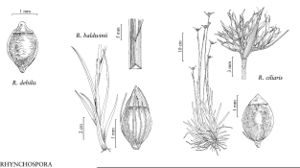Difference between revisions of "Rhynchospora baldwinii"
Ann. Lyceum Nat. Hist. New York 3: 210. 1835.
FNA>Volume Importer |
FNA>Volume Importer |
Revision as of 21:08, 16 December 2019
Plants perennial, cespitose, 40–100 cm; rhizomes absent. Culms stiffly erect to ascending, linear, leafy toward base, sharply trigonous, angles scabrid. Leaves shorter than culm; basal leaves forming strong rosette, shortlinear, flat, 3–5 mm wide, distal more widely spaced, narrower, apex shortacuminate, trigonous. Inflorescences: spikelet clusters 1(–2), if 2 then closely set; terminal cluster mostly dense, hemispheric; proximalmost leafy bract subulate, much exceeding clusters. Spikelets dark redbrown, ovoid, (4–)5–6 mm, apex acute; fertile scales ovate, mostly 4–4.5 mm, apex excurvedcuspidate. Flowers: bristles 12, reaching to or slightly beyond tubercle tip, antrorsely barbellate. Fruits 1–2 per spikelet, 3–3.5(–3.7) mm; body dark brown with paler center, dull, broadly ellipsoid-lenticular, 2–2.5 × 1.8–2 mm, smooth, margins flowing to tubercle; tubercle flat, concavely triangular, 0.7–1(–1.2) mm.
Phenology: Fruiting spring–fall.
Habitat: Sandy peats in low savannas, pine flatwoods, seeps, and bogs
Elevation: 0–100 m
Distribution

Ala., Fla., Ga., La., Miss., N.C., S.C.
Discussion
Selected References
None.
